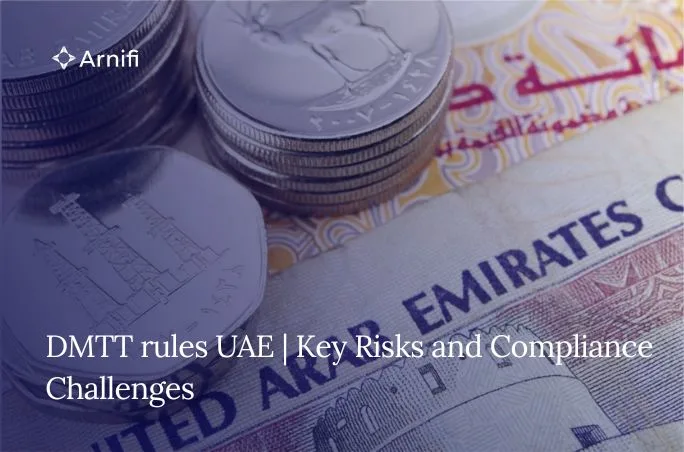Why the DMTT Matters | Key Risks and Compliance Challenges for MNEs in the UAE
by
Ishika Bhandari
Nov 28, 2025  8 MIN READ
8 MIN READ

Table of contents
Large groups used to think of the UAE as a low tax hub with simple rules. That picture has changed. Corporate tax now applies in most cases, and the domestic minimum top up tax sits on top for big multinational groups.
The DMTT rules UAE turn the OECD global minimum tax idea into a local requirement and lift the effective rate on in scope UAE profits to 15 percent.
Let’s know why those rules matter, where the main risks sit, and how tax teams can turn them into a controlled process instead of a last minute crisis.
Understanding the DMTT Rules in the UAE
Domestic Minimum Top Up Tax is a qualifying domestic minimum top up tax. It applies to Constituent Entities in multinational groups that have global consolidated revenue of at least EUR 750 million in at least two of the four years before the test year.
Cabinet Decision No. 142 of 2024 sets the technical rules for calculating Pillar Two income, adjusted covered taxes and top up tax for those entities. It confirms that DMTT applies for fiscal years that start on or after 1 January 2025.
In simple terms, the regime:
- Aggregates GloBE style income for all in scope UAE entities.
- Works out covered taxes linked to that income, including corporate tax and some deferred tax.
- Compares the result to a 15 percent minimum effective tax rate.
- Charges a domestic top up where the rate is lower, so the UAE keeps that extra tax instead of leaving it to foreign Pillar Two rules.
Arnifi’s accounting and bookkeeping services in the UAE helps large groups keep ledgers tied to tax adjustments and DMTT data so every GloBE calculation links back to a clean audit trail.
Why DMTT Rules Matter for MNEs?
For many groups, the UAE corporate tax law at 9 percent was already a big shift. Federal Decree Law No. 47 of 2022 and its guides set a new base regime, bringing in registration timelines, tax groups and transfer pricing rules.
The DMTT layer changes the planning picture again. If a group in scope pays only 9 percent corporate tax in the UAE and the GloBE calculation confirms that rate, a 6 percent top up will usually follow so the jurisdiction reaches 15 percent.
That means:
- Low or zero rate incentives in the UAE still exist, yet they no longer guarantee low global tax when the group falls inside Pillar Two.
- Effective tax rate management now sits at jurisdiction level, not only at entity or legal form level.
Boards care because global minimum tax rules can turn a local planning idea into a group level risk if the numbers are not clear.
Main Risk Areas Under DMTT Rules in the UAE
Most risks link back to the same themes that appear across Pillar Two guidance worldwide.
1. Scoping Errors
Groups first need to know if they pass the revenue test and which entities count as Constituent Entities for DMTT. OECD and UAE materials both stress the EUR 750 million threshold and the two year test.
Complex merger or demerger histories can confuse that test. If a group treats itself as out of scope and later finds it was in, the catch up can involve several years of adjusted calculations.
2. Data and Systems Gaps
The regime demands detailed GloBE data at jurisdiction level. Many existing ledgers and consolidation tools store tax numbers by entity without the adjustments that GloBE needs.
Big firm alerts note that MNEs often lack clean data on deferred tax, equity gains and excluded income lines when they run first test models. If the data pipeline is weak, every filing cycle turns into a manual scramble and the chance of errors rises.
3. Free Zone and Incentive Exposure
The UAE still offers free zone regimes and other incentives under the corporate tax law. For groups in scope, those regimes can pull down the jurisdictional effective tax rate. DMTT then adds top up tax that may erode the headline benefit.
If a planning idea relies only on a low local rate, it is now fragile once the minimum kicks in.
4. Governance and Disclosure Risk
Pillar Two frameworks expect strong governance. Market notes make it clear that tax authorities will use global minimum tax data to test group risk profiles and that audit committees must understand the numbers, not just sign the returns.
Weak sign off chains or unclear ownership of DMTT calculations can turn a technical regime into a reputational issue.
Building a Practical DMTT Compliance Checklist for UAE Groups
Many teams ask what a simple DMTT compliance checklist UAE should look like in the first two years. There is no single official template yet, yet public guidance and professional checklists point in the same direction.
A basic UAE DMTT Checklist usually covers:
- Scope review that confirms revenue thresholds and lists all in scope UAE Constituent Entities.
- Mapping of each entity to its accounting standard, local tax status and free zone position.
- Data gap analysis that tests which GloBE fields are already available and which need new tags or processes.
- Design of calculation models, safe harbour use and review steps before filing.
- Governance notes that show Board and audit committee oversight of global minimum tax exposure.
Groups that already run strong corporate tax checklists in the UAE can fold these points into existing calendars instead of building a separate silo. Many MNEs rely on Arnifi to fold this UAE DMTT checklist into their monthly close, with bookkeeping routines that feed ready numbers into domestic top up and global minimum tax models.
Linking DMTT to Wider MNE Tax Compliance
The DMTT sits inside a wider picture of MNE Tax Compliance. The OECD Pillar Two framework aims to ensure that multinational groups with revenue above EUR 750 million pay at least 15 percent tax in each jurisdiction where they earn income.
That means UAE tax teams cannot treat DMTT in isolation. They need to coordinate with global colleagues on:
- How UAE numbers feed into group level top up tests and foreign income inclusion rules.
- How local transfer pricing and financing choices affect the effective rate in both UAE and other key hubs.
For many boards, this is now part of a broader MNE Global Minimum Tax UAE story. They want to see how the UAE regime fits into the global matrix of minimum taxes and where the pressure points are across the group.
Final Advice and How Arnifi Can Help
The DMTT framework turns the UAE into a jurisdiction where low headline rates need careful data and governance to stay safe. For large groups, ignoring the regime is not an option. Good planning now means clear scoping, clean data flows and realistic forecasts of top up exposure before the first fiscal year starts.
Arnifi works with multinational groups that use the UAE as a hub. The firm helps tax teams interpret the DMTT rules UAE in the context of their own structures, build practical checklists and connect EmaraTax, corporate tax and DMTT data into one controlled process. With that support, boards can treat global minimum tax as a managed risk, not a constant source of surprise.
FAQs
Q1. Which groups fall under the UAE DMTT rules?
Groups with consolidated global revenue of at least EUR 750 million in at least two of the last four years, and with UAE Constituent Entities, fall inside the DMTT scope.
Q2. When do DMTT rules start to apply in the UAE?
The domestic minimum top up tax applies for fiscal years that begin on or after 1 January 2025, so calendar year groups first face it for their 2025 financial year.
Q3. Does DMTT change the 9 percent corporate tax rate in the UAE?
No. Corporate tax stays at 9 percent above the basic band. DMTT adds a top up when the jurisdictional effective tax rate on in scope profits falls below 15 percent.
Q4. How does DMTT affect free zone entities in multinational groups?
Free zone incentives can still reduce normal corporate tax. If that pushes the effective rate below 15 percent for in scope groups, DMTT may claw back part of the benefit through a top up.
Q5. What first steps should MNEs take to prepare for DMTT compliance?
Groups should run a scoping review, assess data gaps, design simple calculation models and set governance roles. Many then bring in advisers like Arnifi to test dry run numbers before filings.
Top UAE Packages

Related Articles
Top UAE Packages



